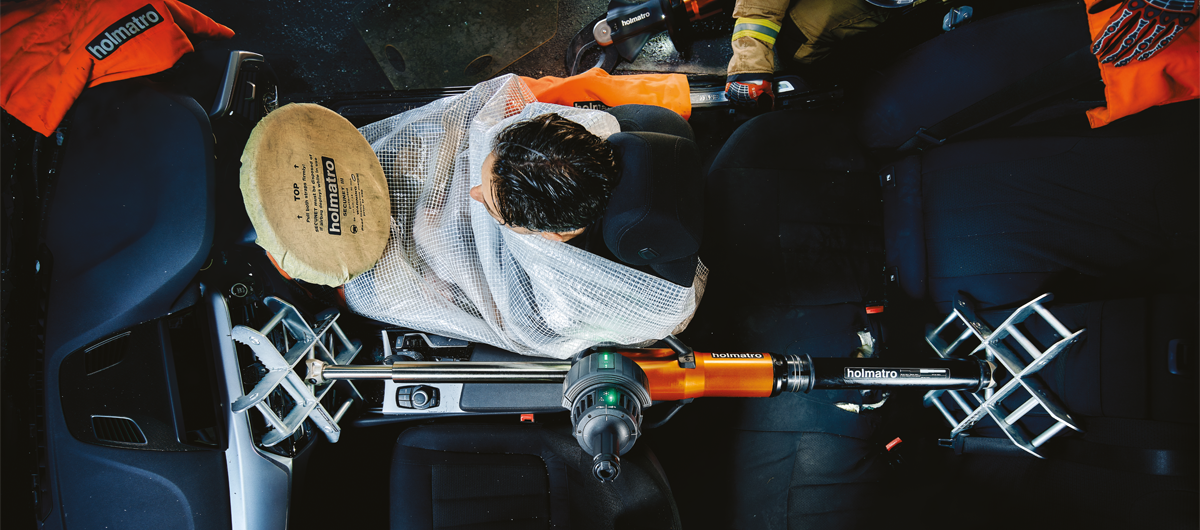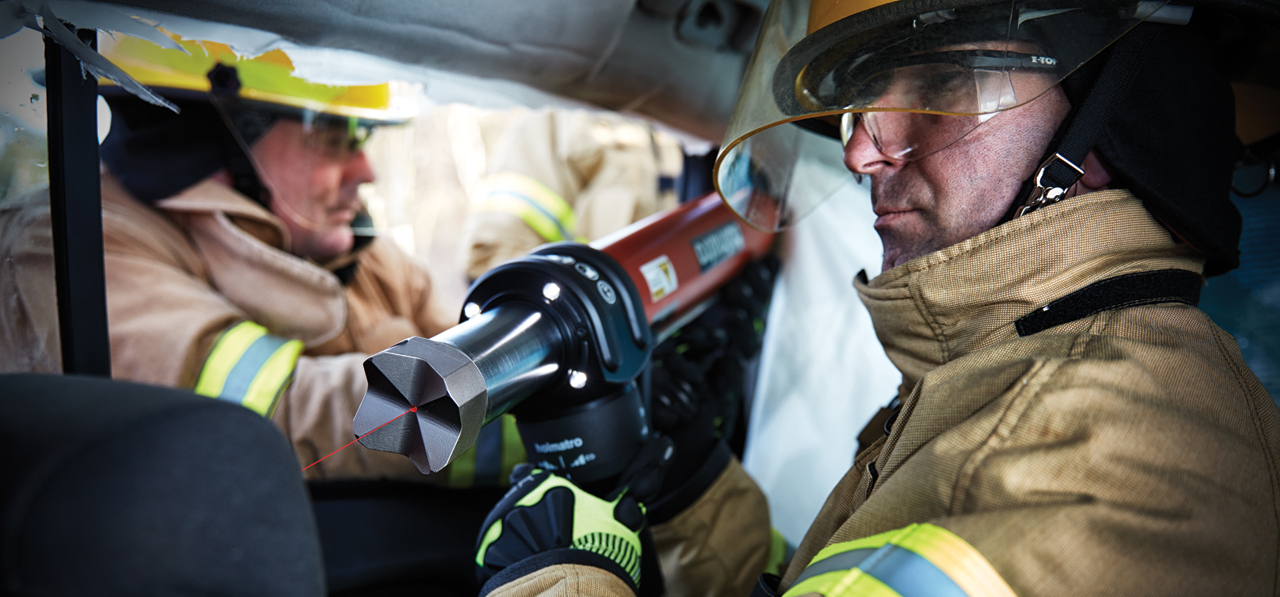Cross ramming: An inside job
Cross ramming is a technique that involves pushing the construction of a vehicle back to its original shape as much as possible. Contrary to what the term suggests, this can not always just be done with a ram, but also with help of a spreader or even a combi tool. When a car is severely deformed, a ram will not always fit immediately and you must first create an opening using a spreader or combi tool. How do you apply cross ramming safely and effectively?

Give the bodywork a nudge
When I started working as a bodywork repairman 28 years ago, I carried out all kinds of repairs: from small scratches on a door to straightening a car on a chassis straightening bench in order to get it back on the road in its original shape. During busy times or just before the weekend, we sometimes had to carry out emergency repairs to ensure that a customer could still use their car. For instance, a door that no longer opened or closed properly due to the bodywork being too strongly deformed. We would resolve such an issue by applying pressure from the inside using a multi purpose cylinder set, to give the bodywork just that little nudge and allow our customer to continue on their way until the car could be repaired.
Removing the roof
When I started my firefighter training in 1999, freeing the victim was focused on removing the roof, with the aim of getting the victim out of the vehicle in as straight a line as possible. Returning the vehicle to its original state from the inside was a technique that was not being used or practiced. As a result of new insights and changing protocols among medical staff, we are now increasingly looking at other ways of freeing victims. We are also increasingly seeing the approach of creating space from the inside out. At the fire brigade, we call this method cross ramming. In the field and during training, this technique can lead to new knowledge about the vehicle or bodywork.
Why cross ramming?
When the fire brigade is called in to free someone from their car, the idea is not that they will simply apply some pressure manoeuvres from the inside out to allow the driver to continue on their way. It can, however, provide just that little extra space to allow a medic to access the vehicle for life-saving actions, relieve a trapped limb and perhaps allow the victim to assume a more comfortable position. Cross ramming can also help the rescue worker to find a better position for the cutter or spreader.
How does cross ramming work?
 Cross ramming has everything to do with relative strength. When pushing a construction back to its original state, you need a stronger object on the opposite as a push-off point. To push the bodywork back to its original position, we use a ram or a spreader. A combi tool can also be used to take the first step towards creating space. Once there is enough space, you can easily follow it up with a ram.
Cross ramming has everything to do with relative strength. When pushing a construction back to its original state, you need a stronger object on the opposite as a push-off point. To push the bodywork back to its original position, we use a ram or a spreader. A combi tool can also be used to take the first step towards creating space. Once there is enough space, you can easily follow it up with a ram.
The tool will always move towards the direction of the weaker part. You are attempting to move the construction of the car and therefore you have to take into account the concept of relative strength. This means that you have to position the base of your ram at a point that is relatively stronger than the area you are trying to move. If you fail to do so, the structure at the base of your ram will move instead.
This means that it is important to understand the basic construction of vehicles; force distribution is the key to success. If, during your cross-ramming actions, there are moments when you see that the two sides are of equal strength, you can use a special cross ram support. This will increase the surface area of the push-off point, allowing you to influence the relative strength to your advantage.
What do you need to be aware of when cross ramming?
It is important to take the following points into account in order to be able to safely and effectively apply the cross ramming technique.
Peel and peek
In our blog Do you play Russian roulette? we already wrote about the danger of cutting into airbag cylinders. When placing a ram or spreader in areas that could hold an airbag cylinder or seatbelt pretensioner, you will also have to check this carefully first. Strip the interior lining and check the CRS (Crash Recovery System) to prevent pushing off of critical points and accidentally activating the airbag cartridges or seat belt tensioners.
Do I need support materials?
A deformed construction is weakened, making it easier to push the body back to its original shape. It is therefore not always necessary to use cribbing to support the ram or spreader: after all, the push-off point is many times stronger than the deformed bodywork. A good example is pushing off against a seat. If it is intact, the construction of a seat is very strong; in fact, strong enough to be used as a push-off point for pushing the deformed bodywork back into shape. Therefore, do not use a support block when placing the ram against a seat; once the cushion has been pressed in, the ram will usually hit a solid seat base.
First time right positioning
Similar to positioning a ram or spreader on a dash roll or dash lift, it is also important when cross ramming to ensure that the tool is correctly positioned when you start moving the construction. This is because repositioning a tool can cause the structure to spring back, potentially trapping the victim even further. If you use a telescopic ram with laser pointer, it is easier to position the tool correctly: it marks the exact spot where the ram will touch the car structure.

Do not cut
If you opt for cross ramming, do not cut the vehicle structure until it has been returned to its original (desired) shape. If you do cut the structure, the section after the cut will not move along with the force of the ram or spreader. Keeping the vehicle intact will cause movement in the entire structure. As a result, there will also be movement in areas that are inaccessible to the ram or spreader because a victim is blocking this access point. As cross ramming is always performed to get more space near the victim, the movement throughout the bodywork helps bring the victim into a more comfortable position, even in places that are inaccessible to the ram or spreader.
How do you train cross ramming?
Cross ramming is a technique that is not often practiced within the fire brigade. This is due to the fact that the vehicles used for training are often not deformed. Therefore the effect of returning them to their original condition cannot really be properly demonstrated.
Weaken the construction
When working on a car without damage, the only way to push it is to make it bigger than it originally was. To press the car beyond its original shape, we need to weaken the construction. Without applying these weaknesses, the relative strength of the vehicle structure will be greater than any push-off point. In short, to practice cross ramming properly, it is important to have a deformed vehicle. If you do not have a suitable vehicle, you can create wrecks yourself. Have a look at our Rescue Hacks video for some tips on how to do that.
Use a dummy victim
When practicing cross ramming, use a dummy victim if possible. This will help you work more carefully because you have to take victim treatment into account. It also creates additional limitations in identifying push-off points. Operators are then forced to be more creative with their options.
Conclusion
Cross ramming is an underappreciated technique within the fire brigade. You can use it during training to get to know the construction of a vehicle. The tricky part of the technique is that cross ramming only really works well if the vehicle has been deformed, and that is often not an easy thing to achieve in training. Techniques that are not or hardly practiced will often not be the first choice during a rescue operation. This is a pity because if you apply cross ramming correctly, it offers many possibilities to create space in a deformed vehicle in a very short time and in a safe way. The big advantage of the technique is it can be done very quickly once you are experienced with it.
With this blog I wanted to give you some insights and examples to enable you to confidently add cross ramming to the options you have for freeing victims. Don't hesitate to contact me if you have any questions!
I welcome your feedback in the comments.
Marinus Verweijen
Holmatro Rescue Consultant